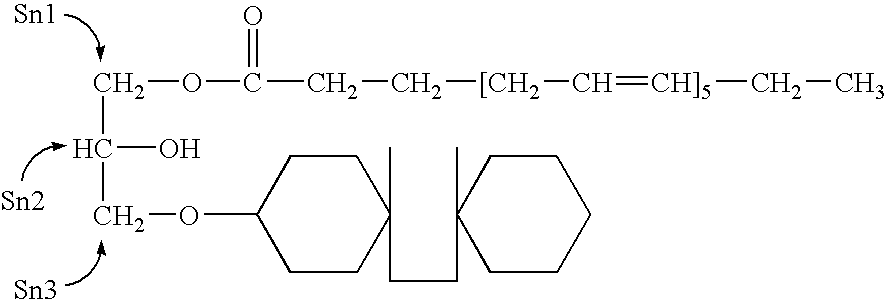Production of ultrapure epa and polar lipids from largely heterotrophic culture
a technology of polar lipids and epa, which is applied in the field of lipid compositions, can solve the problems of not revealing the application of lipase-type or indeed any enzyme, and the method of producing therapeutic or prophylactic compositions, and achieves the effect of efficient passage through endothelial and other peripheral cell membranes
- Summary
- Abstract
- Description
- Claims
- Application Information
AI Technical Summary
Benefits of technology
Problems solved by technology
Method used
Image
Examples
example 1
Mixotrophic Batch Cultures of N. Laevis
[0185]Actively growing cells of the species N. laevis obtained as above are produced in 200 mL of media in stoppered 500 mL Erlenmeyer flasks. Multiple flasks are used to produce large volumes of material. An inoculum of 0.2 g L−1 of exponential or early stationary phase cells is used. Flasks are incubated in temperature- and light-controlled growth chambers by placing them on orbital shakers at around 200 rpm to maintain the cells in suspension and aid in gas transfer between atmosphere and media. Temperature is maintained at 20° C. Light is provided at an average irradiance of photosynthetically active light in the culture of 40 μmol photons m−2 s−1 as measured by an Apogee quantum sensor digital pyranometer and calculated from conditions such as culture depth and cell density. Aliquots of culture are taken during growth to determine the dry weight of the culture at that time point. Cultures are fed a heat sterilised glucose stock solution (...
example 2
Largely Heterotrophic Batch Cultures of N. Laevis
[0199]Flask cultures of N. laevis is produced according to the method of example one except that: 5-10 grams of glucose is added over the course of the culture run. Light is provided at an average irradiance of photosynthetically active light in the culture of 10 μmol photons m−2 s−1. Harvesting, separation and analysis techniques are all according to the method of example one.
Results
[0200]After 72 hours a biomass dry weight reaches between 3 and 5 grams per litre in flask culture. Fatty acids form at least 10% of the dry material grown in the culture. EPA reaches at least 20% of total fatty acids.
[0201]Analysis of the fractions obtained from the first chromatographic column shows that 35 to 40% of fatty acids are recovered in the polar fraction and 60-65% in the non-polar lipid fraction. EPA is preferentially located in the polar fraction.
[0202]Analysis of the fractions by GC shows that between 30 and 40% of the polar fatty acids el...
example 3
“Perfusion Culture” Mode of Culturing N. Laevis Including Variation of Nutrient(s) and / or Exposure to Sub-Photosynthetic Light Intensities
[0206]Larger volumes of actively growing cells of the species N. laevis are grown under closely monitored and controlled conditions in a 20 litre vessel, having an effective working capacity of 18.5 litres. The vessel is internally lined with “Teflon®” and comprise a stirred, jacketed tank. The jacket is provided with hot or cold water as required in order to maintain an internal temperature of 20° C., as sensed by internal probes and 830 controlled with a SCADA device controlling water valves. A mechanical seal admits an impeller shaft of 19 mm diameter, having a 6-blade Rushton impeller at one end, placed near an air sparger, and a marine impellor 250 mm from the end. A 0.25 kW 3-phase 6-pole motor drives the shaft at between 100 and 900 revolutions per minute. Motor speed is controlled with a variable speed drive capable of receiving an analogu...
PUM
| Property | Measurement | Unit |
|---|---|---|
| Fraction | aaaaa | aaaaa |
| Fraction | aaaaa | aaaaa |
| Fraction | aaaaa | aaaaa |
Abstract
Description
Claims
Application Information
 Login to View More
Login to View More - R&D
- Intellectual Property
- Life Sciences
- Materials
- Tech Scout
- Unparalleled Data Quality
- Higher Quality Content
- 60% Fewer Hallucinations
Browse by: Latest US Patents, China's latest patents, Technical Efficacy Thesaurus, Application Domain, Technology Topic, Popular Technical Reports.
© 2025 PatSnap. All rights reserved.Legal|Privacy policy|Modern Slavery Act Transparency Statement|Sitemap|About US| Contact US: help@patsnap.com

